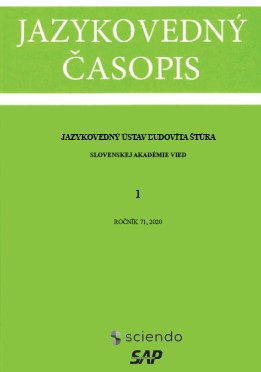VIDÍŠ TÝM LEPŠIE, ČÍM BLIŽŠIE SA POZERÁŠ. SLOVAK COMPARATIVE CORRELATIVE CC’ CONSTRUCTIONS FROM A CONSTRUCTION GRAMMAR PERSPECTIVE
VIDÍŠ TÝM LEPŠIE, ČÍM BLIŽŠIE SA POZERÁŠ. SLOVAK COMPARATIVE CORRELATIVE CC’ CONSTRUCTIONS FROM A CONSTRUCTION GRAMMAR PERSPECTIVE
Author(s): Jakob HorschSubject(s): Semantics, Comparative Linguistics, Western Slavic Languages
Published by: SAV - Slovenská akadémia vied - Jazykovedný ústav Ľudovíta Štúra Slovenskej akadémie vied
Keywords: Slovak Comparative Correlative; CC'; C2C1; Construction Grammar; SketchEngine; iconicity;
Summary/Abstract: The Slovak Comparative Correlative (CC) construction has received little attention, although it is interesting regarding both its semantics and its form: As discussed in Horsch (2019), CCs are characterized by their complex symmetric (parallel change over time) and asymmetric (cause-effect) semantics, which are encoded in a biclausal structure in which each clause consists of a combination of fixed material and obligatory/optional slots. Typically, the first clause (C1) encodes a cause/protasis, and precedes the second clause (C2), which encodes an effect/apodosis: [Čím bližšie sa pozeráš,]C1 [tým lepšie vidíš.]C2 ‘The closer you look, the better you see.’ However, there are also structures that retain the same meaning but in which C2 precedes C1 (often referred to as CC’): [Tým lepšie vidíš]C2 [čím bližšie sa pozeráš.]C1. ‘You see the better, the closer you look.’ Additionally, there is a variant in Slovak where the clause precedes the clause-initial element and comparative element: [Vidíš tým lepšie,]C2 [čím bližšie sa pozeráš.]C1. Embedded in a Usage-based Construction Grammar approach, this is the first large-scale corpus study to investigate the C2C1 order in Slovak, and how semantics influences its formal properties. It is argued that both the significantly higher amount of C1C2 order in the corpus data and the significantly higher amount of C2C1 structures in which the clause precedes the comparative element in C2 can be explained with the principle of iconicity (linguistic form is influenced by the semantics of a construction), which makes certain strings easier to process and thus leads to performance preference. From a cross-linguistic perspective, the present investigation provides evidence in support of Goldberg’s Tenet #5 (2003, p. 219), which posits that cross-linguistic generalizations can be accounted for with general cognitive constraints.
Journal: Jazykovedný časopis
- Issue Year: 71/2020
- Issue No: 1
- Page Range: 25-40
- Page Count: 16
- Language: English

